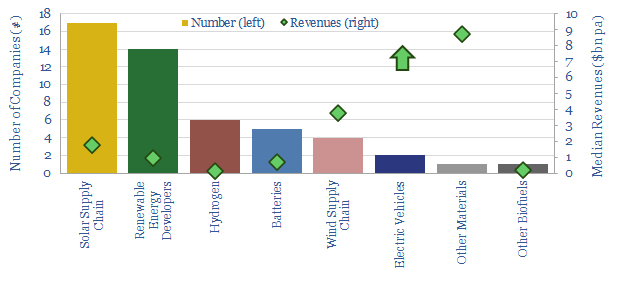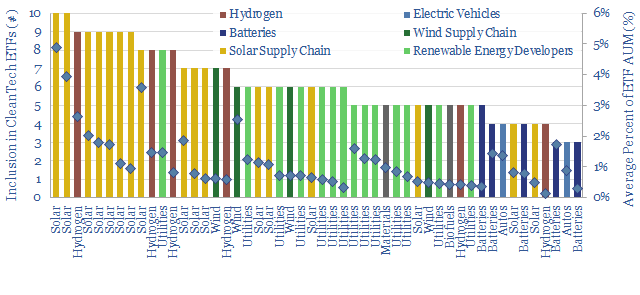Which stocks are most considered to be energy transition stocks? In this data-file we have aggregated the holdings of ten well-known energy transition ETFs and clean tech ETFs, in early 2023. The average ETF has 80 holdings. The entire file contains 300 companies. Our conclusions follow below.
50 companies are most clearly energy transition stocks. They comprise 60% of the total AUM of these 10 ETFs that we reviewed. And each of these 50 companies is featured in six out of ten of the energy transition ETFs on average.
Predictable sectors. Of these top 50 companies, 17 are solar companies, from around the solar supply chain. 14 are renewable energy developers. 6 are hydrogen or fuel cell companies. 5 are companies in the battery supply chain. 4 are wind companies. 2 are EV producers.

Energy transition stocks tend to be younger, smaller and more highly valued than the broader market. The average energy transition stock in our screen was founded in 2001, has $3.4bn in market cap and $1.1bn in revenues (3x price-to-sales). By contrast, the average constituent of the S&P500 is 50 years old, has $30bn pa of sales and $70bn of market cap (2.1x price-to-sales, note the numbers above are rounded).
These disparities were most pronounced for hydrogen companies, which were the smallest of any category in the group but also the most highly valued.
Interestingly, for wind and solar companies, price-to-sales valuations were materially lower than the broader market, especially for wind companies.
Pure-plays. Two-thirds of the top fifty energy transition stocks can be considered to be pure-plays. Pure-play companies are apparently more likely to be included in clean tech ETFs. Whereas diversified companies with growing exposure to the energy transition are more likely to be overlooked.
Many of the companies have specifically been covered in our energy transition research and our patent assessments.
Please download the data-file for an overview of which stocks are most considered to be energy transition stocks. For each company, we have tabulated their domicile, some listing details, market cap, revenues, employee count and a brief description.
